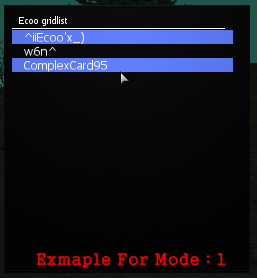GuiGridListSetSelectionMode
Jump to navigation
Jump to search
This function sets the selection mode of a gui gridlist. For example, the MTA server browser selects a whole row, while the Controls dialog selects a single cell. To select multiple items you must be holding down 'ctrl'.
Syntax
bool guiGridListSetSelectionMode ( gui-Element gridlist, int mode )
OOP Syntax Help! I don't understand this!
- Method: GuiGridList:setSelectionMode(...)
- Variable: .selectionMode
Required Arguments
- gridlist: The gridlist in which you wish to set the selection mode.
- mode: The mode of the selection. Can be the following values:
- 0: Single row selection
- 1: Multiple row selection
- 2: Single cell selection
- 3: Multiple cell selection
- 4: Nominated(First) single column selection
- 5: Nominated(First) multiple column selection
- 6: Single column selection
- 7: Multiple column selection
- 8: Nominated(First) single row selection
- 9: Nominated(First) multiple row selection
Returns
Returns true if the selection mode was successfully set, false otherwise.
Example
This example creates a grid list with 3 columns and 3 rows, each with text describing its position in the grid list. Also, the cursor is turned on. The player can use the command 'setmode #' to change how the grid list can be selected.
function clientsideResourceStart ()
--Create a gridlist
myGridList = guiCreateGridList ( 0.35, 0.35, 0.4, 0.1, true )
--Create a column for myGridList to add rows into
columnA = guiGridListAddColumn ( myGridList, "columnA Title", 0.3 )
columnB = guiGridListAddColumn ( myGridList, "columnA Title", 0.3 )
columnC = guiGridListAddColumn ( myGridList, "columnA Title", 0.3 )
--Create a row for columnA
rowA = guiGridListAddRow ( myGridList )
rowB = guiGridListAddRow ( myGridList )
rowC = guiGridListAddRow ( myGridList )
--Set the text of columnA, rowA to "Hello World!"
guiGridListSetItemText ( myGridList, rowA, columnA, "rowA ColumnA", false, false )
guiGridListSetItemText ( myGridList, rowB, columnA, "rowB ColumnA", false, false )
guiGridListSetItemText ( myGridList, rowC, columnA, "rowC ColumnA", false, false )
guiGridListSetItemText ( myGridList, rowA, columnB, "rowA ColumnB", false, false )
guiGridListSetItemText ( myGridList, rowB, columnB, "rowB ColumnB", false, false )
guiGridListSetItemText ( myGridList, rowC, columnB, "rowC ColumnB", false, false )
guiGridListSetItemText ( myGridList, rowA, columnC, "rowA ColumnC", false, false )
guiGridListSetItemText ( myGridList, rowB, columnC, "rowB ColumnC", false, false )
guiGridListSetItemText ( myGridList, rowC, columnC, "rowC ColumnC", false, false )
showCursor ( true )
end
addEventHandler ( "onClientResourceStart", resourceRoot, clientsideResourceStart )
--The player types 'setmode' to activate this function. Additionaly, the player needs
--to type a modeNumber. Ex: 'setmode 5', 5 would be stored as modeNumber
function setSelectionMode ( commandName, modeNumber )
--The player enters the command "setmode #". The modeNumber entry will be a string
--argument. Ex: "9" "nine". Attempt to change modeNumber into a number argument.
modeNumber = tonumber(modeNumber)
--If the selection mode was successfully changed, output a message saying which
--mode it changed to. Otherwise, list reasons why it did not work.
if ( guiGridListSetSelectionMode ( myGridList, modeNumber ) ) then
outputChatBox ( "Changed grid list selection mode to: "..modeNumber )
else
outputChatBox ( "modeNumber must be a number and be between 0 and 9" )
end
end
addCommandHandler ( "setmode", setSelectionMode )
See Also
General functions
- guiBringToFront
- getChatboxLayout
- getChatboxCharacterLimit
- guiCreateFont
- guiBlur
- guiFocus
- guiGetAlpha
- guiGetCursorType
- guiGetEnabled
- guiGetFont
- guiGetInputEnabled
- guiGetInputMode
- guiGetPosition
- guiGetProperties
- guiGetProperty
- guiGetScreenSize
- guiGetSize
- guiGetText
- guiGetVisible
- guiMoveToBack
- guiSetAlpha
- guiSetEnabled
- guiSetFont
- guiSetInputEnabled
- guiSetInputMode
- guiSetPosition
- guiSetProperty
- guiSetSize
- guiSetText
- guiSetVisible
- isChatBoxInputActive
- isConsoleActive
- isDebugViewActive
- isMainMenuActive
- isMTAWindowActive
- isTransferBoxActive
- setChatboxCharacterLimit
- setDebugViewActive
Browsers
Buttons
Checkboxes
Comboboxes
- guiCreateComboBox
- guiComboBoxAddItem
- guiComboBoxClear
- guiComboBoxGetItemCount
- guiComboBoxGetItemText
- guiComboBoxGetSelected
- guiComboBoxIsOpen
- guiComboBoxRemoveItem
- guiComboBoxSetItemText
- guiComboBoxSetOpen
- guiComboBoxSetSelected
Edit Boxes
- guiCreateEdit
- guiEditGetCaretIndex
- guiEditGetMaxLength
- guiEditIsMasked
- guiEditIsReadOnly
- guiEditSetCaretIndex
- guiEditSetMasked
- guiEditSetMaxLength
- guiEditSetReadOnly
Gridlists
- guiCreateGridList
- guiGridListAddColumn
- guiGridListAddRow
- guiGridListAutoSizeColumn
- guiGridListClear
- guiGridListGetColumnCount
- guiGridListGetColumnTitle
- guiGridListGetColumnWidth
- guiGridListGetHorizontalScrollPosition
- guiGridListGetItemColor
- guiGridListGetItemData
- guiGridListGetItemText
- guiGridListGetRowCount
- guiGridListGetSelectedCount
- guiGridListGetSelectedItem
- guiGridListGetSelectedItems
- guiGridListGetSelectionMode
- guiGridListIsSortingEnabled
- guiGridListGetVerticalScrollPosition
- guiGridListInsertRowAfter
- guiGridListRemoveColumn
- guiGridListRemoveRow
- guiGridListSetColumnTitle
- guiGridListSetColumnWidth
- guiGridListSetHorizontalScrollPosition
- guiGridListSetItemColor
- guiGridListSetItemData
- guiGridListSetItemText
- guiGridListSetScrollBars
- guiGridListSetSelectedItem
- guiGridListSetSelectionMode
- guiGridListSetSortingEnabled
- guiGridListSetVerticalScrollPosition
Memos
- guiCreateMemo
- guiMemoGetCaretIndex
- guiMemoGetVerticalScrollPosition
- guiMemoSetVerticalScrollPosition
- guiMemoIsReadOnly
- guiMemoSetCaretIndex
- guiMemoSetReadOnly
Progressbars
Radio Buttons
Scrollbars
Scrollpanes
- guiCreateScrollPane
- guiScrollPaneGetHorizontalScrollPosition
- guiScrollPaneGetVerticalScrollPosition
- guiScrollPaneSetHorizontalScrollPosition
- guiScrollPaneSetScrollBars
- guiScrollPaneSetVerticalScrollPosition
Static Images
Tab Panels
Tabs
Text Labels
- guiCreateLabel
- guiLabelGetColor
- guiLabelGetFontHeight
- guiLabelGetTextExtent
- guiLabelSetColor
- guiLabelSetHorizontalAlign
- guiLabelSetVerticalAlign
Windows
Input
GUI
- onClientGUIAccepted
- onClientGUIBlur
- onClientGUIChanged
- onClientGUIClick
- onClientGUIComboBoxAccepted
- onClientGUIDoubleClick
- onClientGUIFocus
- onClientGUIMouseDown
- onClientGUIMouseUp
- onClientGUIMove
- onClientGUIScroll
- onClientGUISize
- onClientGUITabSwitched
- onClientMouseEnter
- onClientMouseLeave
- onClientMouseMove
- onClientMouseWheel
